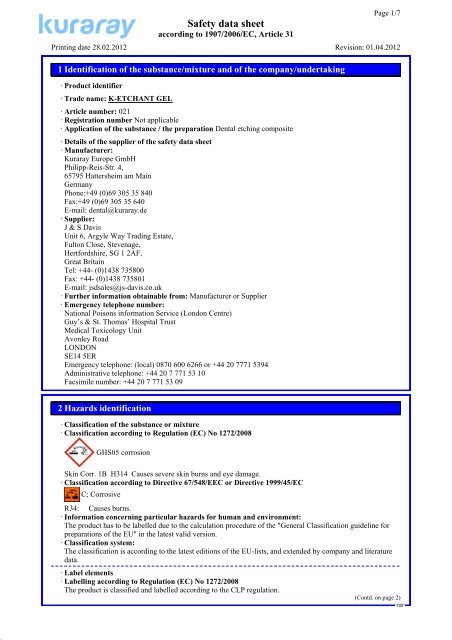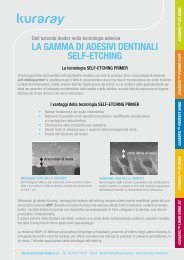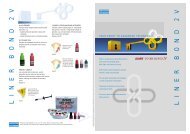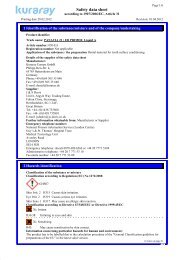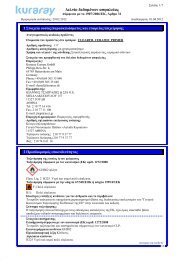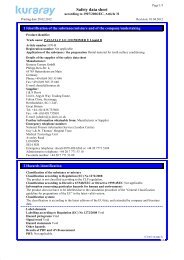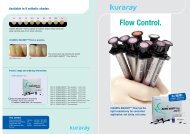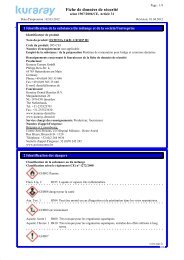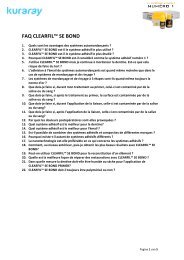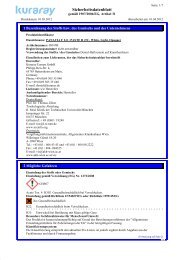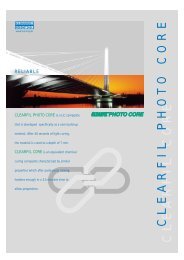k-etchant gel (gb) - Kuraray Dental
k-etchant gel (gb) - Kuraray Dental
k-etchant gel (gb) - Kuraray Dental
Create successful ePaper yourself
Turn your PDF publications into a flip-book with our unique Google optimized e-Paper software.
34.0<br />
Safety data sheet<br />
according to 1907/2006/EC, Article 31<br />
Page 1/7<br />
Printing date 28.02.2012 Revision: 01.04.2012<br />
1 Identification of the substance/mixture and of the company/undertaking<br />
· Product identifier<br />
· Trade name: K-ETCHANT GEL<br />
· Article number: 021<br />
· Registration number Not applicable<br />
· Application of the substance / the preparation <strong>Dental</strong> etching composite<br />
· Details of the supplier of the safety data sheet<br />
· Manufacturer:<br />
<strong>Kuraray</strong> Europe GmbH<br />
Philipp-Reis-Str. 4,<br />
65795 Hattersheim am Main<br />
Germany<br />
Phone:+49 (0)69 305 35 840<br />
Fax:+49 (0)69 305 35 640<br />
E-mail: dental@kuraray.de<br />
· Supplier:<br />
J & S Davis<br />
Unit 6, Argyle Way Trading Estate,<br />
Fulton Close, Stevenage,<br />
Hertfordshire, SG 1 2AF,<br />
Great Britain<br />
Tel: +44- (0)1438 735800<br />
Fax: +44- (0)1438 735801<br />
E-mail: jsdsales@js-davis.co.uk<br />
· Further information obtainable from: Manufacturer or Supplier<br />
· Emergency telephone number:<br />
National Poisons information Service (London Centre)<br />
Guy’s & St. Thomas’ Hospital Trust<br />
Medical Toxicology Unit<br />
Avonley Road<br />
LONDON<br />
SE14 5ER<br />
Emergency telephone: (local) 0870 600 6266 or +44 20 7771 5394<br />
Administrative telephone: +44 20 7 771 53 10<br />
Facsimile number: +44 20 7 771 53 09<br />
2 Hazards identification<br />
· Classification of the substance or mixture<br />
· Classification according to Regulation (EC) No 1272/2008<br />
GHS05 corrosion<br />
Skin Corr. 1B H314 Causes severe skin burns and eye damage.<br />
· Classification according to Directive 67/548/EEC or Directive 1999/45/EC<br />
C; Corrosive<br />
R34: Causes burns.<br />
· Information concerning particular hazards for human and environment:<br />
The product has to be labelled due to the calculation procedure of the "General Classification guideline for<br />
preparations of the EU" in the latest valid version.<br />
· Classification system:<br />
The classification is according to the latest editions of the EU-lists, and extended by company and literature<br />
data.<br />
· Label elements<br />
· Labelling according to Regulation (EC) No 1272/2008<br />
The product is classified and labelled according to the CLP regulation.<br />
(Contd. on page 2)<br />
GB
34.0<br />
Safety data sheet<br />
according to 1907/2006/EC, Article 31<br />
Page 2/7<br />
Printing date 28.02.2012 Revision: 01.04.2012<br />
Trade name: K-ETCHANT GEL<br />
(Contd. of page 1)<br />
· Hazard pictograms GHS05<br />
· Signal word Danger<br />
· Hazard-determining components of labelling:<br />
phosphoric acid<br />
· Hazard statements<br />
H314 Causes severe skin burns and eye damage.<br />
· Precautionary statements<br />
P260<br />
Do not breathe dust/fume/gas/mist/vapours/spray.<br />
P303+P361+P353 IF ON SKIN (or hair): Remove/Take off immediately all contaminated clothing. Rinse<br />
skin with water/shower.<br />
P305+P351+P338 IF IN EYES: Rinse cautiously with water for several minutes. Remove contact lenses, if<br />
present and easy to do. Continue rinsing.<br />
P310<br />
Immediately call a POISON CENTER or doctor/physician.<br />
P405<br />
P501<br />
Store locked up.<br />
Dispose of contents/container in accordance with local/regional/national/international<br />
regulations.<br />
· Other hazards<br />
· Results of PBT and vPvB assessment<br />
· PBT: Not applicable.<br />
· vPvB: Not applicable.<br />
3 Composition/information on ingredients<br />
· Chemical characterization: Mixtures<br />
· Description: Mixture of substances listed below with nonhazardous additions.<br />
· Dangerous components:<br />
CAS: 7664-38-2<br />
EINECS: 231-633-2<br />
· Other ingredients:<br />
Colloidal silica<br />
Water<br />
Dyes<br />
phosphoric acid C R34<br />
Skin Corr. 1B, H314<br />
35-45%<br />
4 First aid measures<br />
· Description of first aid measures<br />
· General information: Immediately remove any clothing soiled by the product.<br />
· After inhalation: In case of unconsciousness place patient stably in side position for transportation.<br />
· After skin contact: Immediately wash with water and soap and rinse thoroughly.<br />
· After eye contact: Rinse opened eye for several minutes under running water. Then consult a doctor.<br />
· After swallowing: Drink plenty of water and provide fresh air. Call for a doctor immediately.<br />
· Information for doctor:<br />
· Most important symptoms and effects, both acute and delayed No further relevant information available.<br />
· Indication of any immediate medical attention and special treatment needed<br />
No further relevant information available.<br />
5 Firefighting measures<br />
· Extinguishing media<br />
· Suitable extinguishing agents:<br />
CO2, powder or water spray. Fight larger fires with water spray or alcohol resistant foam.<br />
· Special hazards arising from the substance or mixture No further relevant information available.<br />
(Contd. on page 3)<br />
GB
34.0<br />
Safety data sheet<br />
according to 1907/2006/EC, Article 31<br />
Page 3/7<br />
Printing date 28.02.2012 Revision: 01.04.2012<br />
Trade name: K-ETCHANT GEL<br />
· Advice for firefighters<br />
· Protective equipment:<br />
Wear self-contained respiratory protective device.<br />
Wear fully protective suit.<br />
(Contd. of page 2)<br />
6 Accidental release measures<br />
· Personal precautions, protective equipment and emergency procedures<br />
Wear protective equipment. Keep unprotected persons away.<br />
· Environmental precautions:<br />
Dilute with plenty of water.<br />
Do not allow to enter sewers/ surface or ground water.<br />
· Methods and material for containment and cleaning up:<br />
Absorb with liquid-binding material (sand, diatomite, acid binders, universal binders, sawdust).<br />
Use neutralizing agent.<br />
Dispose contaminated material as waste according to item 13.<br />
Ensure adequate ventilation.<br />
· Reference to other sections<br />
See Section 7 for information on safe handling.<br />
See Section 8 for information on personal protection equipment.<br />
See Section 13 for disposal information.<br />
7 Handling and storage<br />
· Handling:<br />
· Precautions for safe handling<br />
Ensure good ventilation/exhaustion at the workplace.<br />
Prevent formation of aerosols.<br />
· Information about fire - and explosion protection: No special measures required.<br />
· Conditions for safe storage, including any incompatibilities<br />
· Storage:<br />
· Requirements to be met by storerooms and receptacles: Store in a cool location (2-25°C).<br />
· Information about storage in one common storage facility:<br />
Store away from oxidizing agents.<br />
Store away from reducing agents.<br />
· Further information about storage conditions:<br />
Keep container tightly sealed.<br />
Store in cool, dry conditions in well sealed receptacles.<br />
Protect from heat and direct sunlight.<br />
· Specific end use(s) No further relevant information available.<br />
8 Exposure controls/personal protection<br />
· Additional information about design of technical facilities: No further data; see item 7.<br />
· Control parameters<br />
· Ingredients with limit values that require monitoring at the workplace:<br />
7664-38-2 phosphoric acid<br />
WEL Short-term value: 2 mg/m³<br />
Long-term value: 1 mg/m³<br />
· Additional information: The lists valid during the making were used as basis.<br />
(Contd. on page 4)<br />
GB
34.0<br />
Safety data sheet<br />
according to 1907/2006/EC, Article 31<br />
Page 4/7<br />
Printing date 28.02.2012 Revision: 01.04.2012<br />
Trade name: K-ETCHANT GEL<br />
(Contd. of page 3)<br />
· Exposure controls<br />
· Personal protective equipment:<br />
· General protective and hygienic measures:<br />
Immediately remove all soiled and contaminated clothing<br />
Wash hands before breaks and at the end of work.<br />
Avoid contact with the eyes and skin.<br />
· Respiratory protection:<br />
In case of brief exposure or low pollution use respiratory filter device. In case of intensive or longer exposure<br />
use self-contained respiratory protective device.<br />
· Protection of hands:<br />
Protective gloves<br />
The glove material has to be impermeable and resistant to the product/ the substance/ the preparation.<br />
Due to missing tests no recommendation to the glove material can be given for the product/ the preparation/<br />
the chemical mixture.<br />
Selection of the glove material on consideration of the penetration times, rates of diffusion and the<br />
degradation<br />
· Material of gloves<br />
The selection of the suitable gloves does not only depend on the material, but also on further marks of quality<br />
and varies from manufacturer to manufacturer. As the product is a preparation of several substances, the<br />
resistance of the glove material can not be calculated in advance and has therefore to be checked prior to the<br />
application.<br />
· Penetration time of glove material<br />
The exact break trough time has to be found out by the manufacturer of the protective gloves and has to be<br />
observed.<br />
· Eye protection:<br />
Tightly sealed goggles<br />
9 Physical and chemical properties<br />
· Information on basic physical and chemical properties<br />
· General Information<br />
· Appearance:<br />
Form:<br />
Gel<br />
Colour:<br />
Red<br />
· Odour: Odourless<br />
· pH-value: 1.8<br />
· Change in condition<br />
Melting point/Melting range:<br />
Boiling point/Boiling range:<br />
42.4 °C (phosphoric acid)<br />
Undetermined.<br />
· Flash point: Not applicable.<br />
· Ignition temperature: Not applicable<br />
· Danger of explosion: Product does not present an explosion hazard.<br />
· Explosion limits:<br />
Lower:<br />
Not applicable<br />
(Contd. on page 5)<br />
GB
34.0<br />
Safety data sheet<br />
according to 1907/2006/EC, Article 31<br />
Page 5/7<br />
Printing date 28.02.2012 Revision: 01.04.2012<br />
Trade name: K-ETCHANT GEL<br />
(Contd. of page 4)<br />
Upper:<br />
Not applicable<br />
· Vapour pressure: Not applicable<br />
· Density: 1.3 g/cm³<br />
· Vapour density Not applicable<br />
· Solubility in / Miscibility with<br />
water:<br />
Partly miscible.<br />
· Segregation coefficient (n-octanol/water): Not applicable<br />
· Other information No further relevant information available.<br />
10 Stability and reactivity<br />
· Reactivity<br />
· Chemical stability<br />
· Thermal decomposition / conditions to be avoided: No decomposition if used according to specifications.<br />
· Possibility of hazardous reactions No dangerous reactions known.<br />
· Conditions to avoid No further relevant information available.<br />
· Incompatible materials: No further relevant information available.<br />
· Hazardous decomposition products: Carbon monoxide and carbon dioxide<br />
11 Toxicological information<br />
· Information on toxicological effects<br />
· Acute toxicity:<br />
· LD/LC50 values relevant for classification:<br />
7664-38-2 phosphoric acid<br />
Oral LD50 1250 mg/kg (mouse)<br />
1250 mg/kg (rat)<br />
Dermal LD50 2740 mg/kg (rabbit)<br />
· Primary irritant effect:<br />
· on the skin: Caustic effect on skin and mucous membranes.<br />
· on the eye: Strong caustic effect.<br />
· Sensitization: No sensitizing effects known.<br />
· Additional toxicological information:<br />
The product shows the following dangers according to the calculation method of the General EU<br />
Classification Guidelines for Preparations as issued in the latest version:<br />
Corrosive<br />
Swallowing will lead to a strong caustic effect on mouth and throat and to the danger of perforation of<br />
esophagus and stomach.<br />
12 Ecological information<br />
· Toxicity<br />
· Aquatic toxicity: No further relevant information available.<br />
· Persistence and degradability No further relevant information available.<br />
· Behaviour in environmental systems:<br />
· Bioaccumulative potential No further relevant information available.<br />
· Mobility in soil No further relevant information available.<br />
· Additional ecological information:<br />
· General notes:<br />
Water hazard class 1 (German Regulation) (Self-assessment): slightly hazardous for water<br />
(Contd. on page 6)<br />
GB
34.0<br />
Safety data sheet<br />
according to 1907/2006/EC, Article 31<br />
Page 6/7<br />
Printing date 28.02.2012 Revision: 01.04.2012<br />
Trade name: K-ETCHANT GEL<br />
(Contd. of page 5)<br />
Do not allow undiluted product or large quantities of it to reach ground water, water course or sewage system.<br />
Must not reach sewage water or drainage ditch undiluted or unneutralized.<br />
Rinse off of bigger amounts into drains or the aquatic environment may lead to decreased pH-values. A low<br />
pH-value harms aquatic organisms. In the dilution of the use-level the pH-value is considerably increased, so<br />
that after the use of the product the aqueous waste, emptied into drains, is only low water-dangerous.<br />
· Results of PBT and vPvB assessment<br />
· PBT: Not applicable.<br />
· vPvB: Not applicable.<br />
· Other adverse effects No further relevant information available.<br />
13 Disposal considerations<br />
· Waste treatment methods<br />
· Recommendation<br />
Must not be disposed together with household garbage. Do not allow product to reach sewage system.<br />
· Uncleaned packaging:<br />
· Recommendation: Disposal must be made according to official regulations.<br />
· Recommended cleansing agents: Water, if necessary together with cleansing agents.<br />
14 Transport information<br />
· UN-Number<br />
· ADR, IMDG, IATA 1805<br />
· UN proper shipping name<br />
· ADR 1805 PHOSPHORIC ACID, SOLUTION<br />
· IMDG, IATA PHOSPHORIC ACID, SOLUTION<br />
· Transport hazard class(es)<br />
· ADR<br />
· Class 8 Corrosive substances.<br />
· Label 8<br />
· IMDG, IATA<br />
· Class 8 Corrosive substances.<br />
· Label 8<br />
· Packing group<br />
· ADR, IMDG, IATA III<br />
· Environmental hazards:<br />
· Marine pollutant: No<br />
· Special precautions for user Warning: Corrosive substances.<br />
· Danger code (Kemler): 80<br />
· EMS Number: F-A,S-B<br />
(Contd. on page 7)<br />
GB
34.0<br />
Safety data sheet<br />
according to 1907/2006/EC, Article 31<br />
Page 7/7<br />
Printing date 28.02.2012 Revision: 01.04.2012<br />
Trade name: K-ETCHANT GEL<br />
· Transport in bulk according to Annex II of<br />
MARPOL73/78 and the IBC Code<br />
Not applicable.<br />
· UN "Model Regulation": UN1805; PHOSPHORIC ACID, SOLUTION; 8; III<br />
(Contd. of page 6)<br />
15 Regulatory information<br />
· Chemical safety assessment: A Chemical Safety Assessment has not been carried out.<br />
16 Other information<br />
This information is based on our present knowledge. However, this shall not constitute a guarantee for any<br />
specific product features and shall not establish a legally valid contractual relationship.<br />
· Version: 6<br />
· Relevant phrases<br />
Not applicable<br />
H314 Causes severe skin burns and eye damage.<br />
R34<br />
Causes burns.<br />
GB


